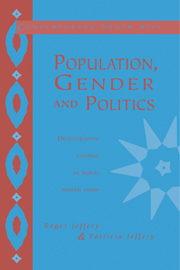Book contents
1 - An island of peace?
Published online by Cambridge University Press: 07 January 2010
Summary
When we were first looking for a research site, in 1982, one of the attractions of Bijnor District was its reputation for intercommunity and intercaste peace, and its freedom from organized crime, by comparison with some of the neighbouring districts. According to the national press, Bijnor was not involved in the violence which affected Hindu–Muslim relations in the late 1970s (unlike neighbouring Moradabad and Meerut). Nor was it affected by the dakaitè (armed burglary) which mushroomed in the early 1980s. Bijnor lies just below the foothills of the Himalayas, to the east of the River Ganges after it reaches the plains at Hardwar and flows through Uttar Pradesh, Bihar and Bengal to the sea. It seemed to be a backwater, out of the mainstream of national political life. The villages of Dharmnagri and Jhakri, five kilometres north-west of Bijnor town, were the sites of our research in 1982–3 and in 1985. Village residents, as well as our contacts in Bijnor town, used the events of Independence and Partition in 1947 to provide the clinching argument. Despite the presence there of large numbers of Muslims, Bijnor had remained free of trouble when Hindu–Muslim and Sikh–Muslim rioting and communal violence was widespread in Punjab (to the west) and in Bengal (to the east). That was as far back as local political memories went.
A modest amount of historical research, however, produced evidence to suggest that the district had experienced considerable violence in the nineteenth century, which had been interpreted by the British colonial Government as communalist in nature.
- Type
- Chapter
- Information
- Population, Gender and PoliticsDemographic Change in Rural North India, pp. 1 - 37Publisher: Cambridge University PressPrint publication year: 1997

